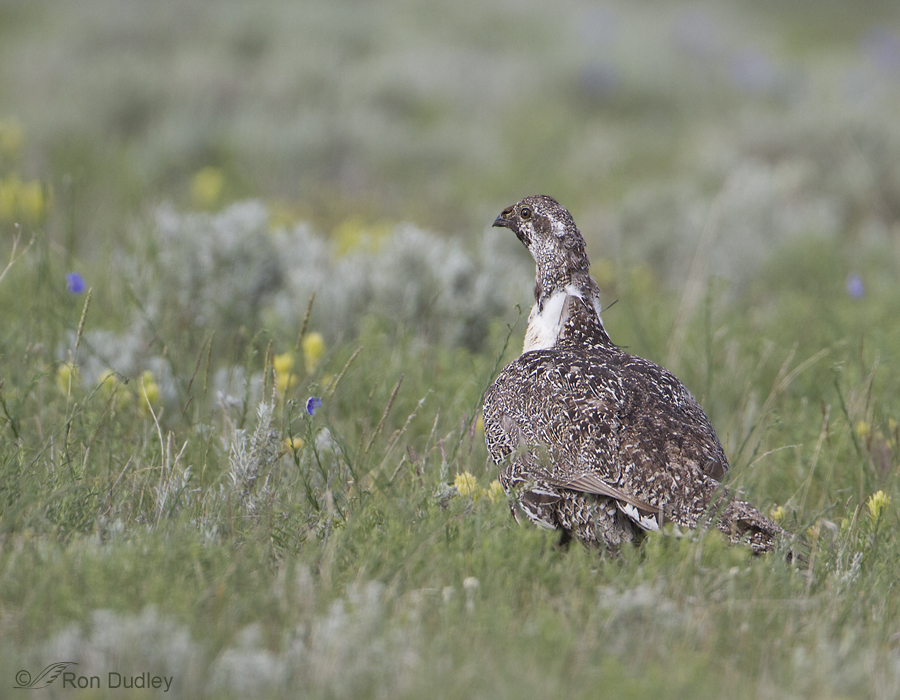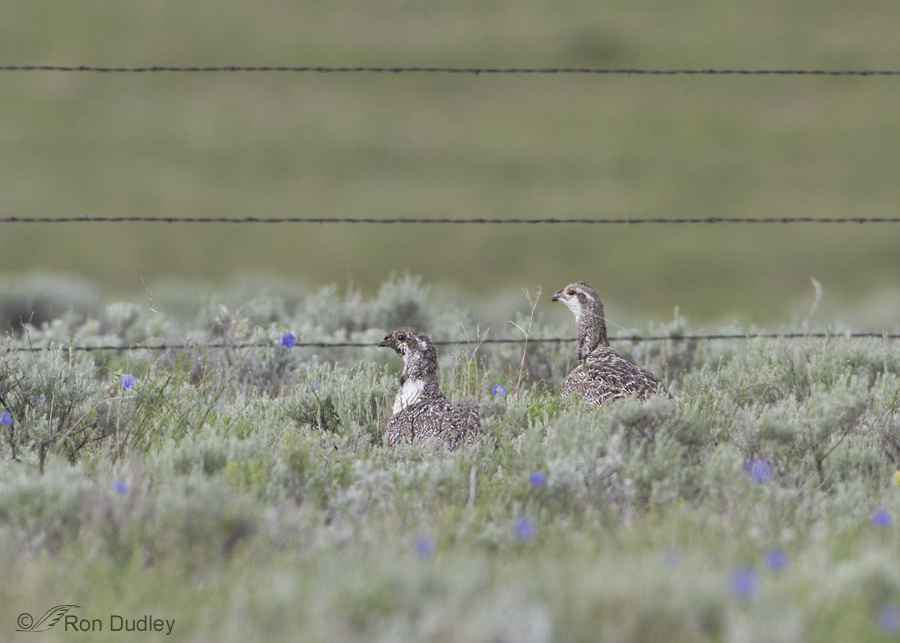The Greater Sage-Grouse is a spectacular bird in many ways. They’re our largest grouse – males may approach 7 lbs. The dramatic breeding display of the males on the lek is mind-boggling. And to have one of these birds flush at your feet is literally a heart-stopping experience – something I know from experience.
But these birds are in great danger due to dramatic loss of habitat.
On my last Montana trip several weeks ago I came across several of these grouse just as I was leaving the Centennial Valley. These were the first of the species I’d encountered in many years and I was thrilled to see them. I didn’t get any great photos of them so I had no plans to post any – until a few days ago when Nicole, one of my regular readers, sent me a link to a recent story done by National Public Radio on the plight of the Sage-Grouse in Montana’s Centennial Valley and elsewhere.
An epic battle, a “21st century range war”, is likely about to begin with environmentalists and the federal government on one side and ranchers and energy companies on the other over the survival of this species . The Fish and Wildlife Service will decide within two years if it will add the Greater Sage-Grouse to the formal list of endangered species. If that happens ranchers worry that they’ll be prevented from grazing cattle near endangered birds and energy companies fear they won’t be able to drill.
But something new is being tried to hopefully prevent such a “range war” from occurring – it’s called the Sage Grouse Initiative. The SGI was initiated by the USDA’s Natural Resources Conservation Service and the program is a consortium that includes the Nature Conservancy and the wildlife agencies and universities of several states. It’s goal is to protect grouse now so the feds don’t have to list the bird as endangered – a step that would surely start a protracted battle between the government and ranchers and energy companies. Both ranchers and “critters” depend on the sagebrush steppes in the west and this initiative is an ambitious attempt to bring both sides together for a common goal – an “unlikely alliance”.
One of the things mentioned in the NPR story that threatens these grouse (and other species, pronghorn in particular) is fences like this one. These heavy-bodied birds often hit the wires in flight and die. As I was photographing these two grouse they obviously saw my pickup (on the road) as a potential threat and they were deliberately walking away to get at a safe distance from me. But when they came to the fence they were obviously confused by it and stopped in their tracks, looking alternately at the fence and back at me. I’m just glad they didn’t fly in a panic and hit the fence.
The Sage Grouse Initiative is unique, innovative and ambitious. It’s likely the largest conservation experiment that has ever been conducted in the United States – larger even than the huge effort that was made to save the Spotted Owl in the Pacific Northwest. I strongly encourage my readers to follow this NPR link and read about the SGI in the Centennial Valley – it’s goals, the means to those goals and the potential stumbling blocks in its path. There’s even a link in the story to a clip of Sage-Grouse displaying on the lek – always an entartaining treat!
This post isn’t about my mediocre images – it’s about a near-heroic effort to save a bird and some very special habitat with the other species that go along with it. I’ll leave it to NPR to explain it – they do it much more effectively than I could. I hope the SGI succeeds and that you’ll visit the link.
Thanks for providing it, Nicole!
Ron




An interesting post with photo Mr. Dudley. I’d like to turn your attention to our http://WWW.FENCE-FLAG.COM web site and give you the opportunity to view and read the efforts of the Sierra Club and The Nature Conservancy of Idaho’s efforts to mitigate the dire consequences of Sage Grouse and ungulates from impacting undetected Barbed Wire Fencing; a concerning topic you adressed. Barbed Wire fence lines, that are a prefered and common property identifing barrier thru out the western states, is as problematic today as when it was called “Devels Rope” soon after Joseph Glidden patented it in the late 1800s—and a party to the range wars that followed. DJK
Your fence flags are an interesting concept, Donald. I like the idea if it helps wildlife, with a couple of (possible) caveats.
I checked out your website and saw that the flags are being used in at least a couple of instances but are there any reliable studies that indicate they really make a difference? Perhaps I missed it…
I also have at least some misgivings about the visual pollution (for want of a better phrase) caused by these flags. I don’t like barbed wire for obvious reasons but unless there’s documented evidence that these flags really make a difference to wildlife (it makes sense that they would but I’d like to see the evidence) I’m not sure about the tradeoff. As someone who really enjoys the expansiveness of western vistas these flags need to make a difference. Just asking…
Thanks for your photos of course but thanks for the NPR link. In reading it I am reminded that I, too, can work with people I do not agree with to achieve a common goal.
The lesson behind the photos.is as clear as the photos themselves.
“In reading it I am reminded that I, too, can work with people I do not agree with to achieve a common goal.
The lesson behind the photos.is as clear as the photos themselves.”
Perfectly said, Diana.
Hi Ron,
Thanks for this post and promoting this effort. In New Mexico, the Lesser Prairie Chicken faces some similar problems. Much work has been done cooperatively among environmentalists, ranchers and government agencies. One thing that has helped is placing plastic flags along wire fence lines to make them more visible to the birds and reduce strikes.
Cheers,
Gail
Gail, I’m delighted to hear of such cooperation between some of these disparate groups. Perhaps there is some hope…
Your heart-stopping grouse explosion must be much like the heart-stopping, almost underfoot, explosion of the ringed-neck pheasant here in the east. They can actually turn your knees to rubber and make your finger tips tingle!
Ron, Your storyy of the grouse returning to his iced covered lek on what has been flooded for areservoir, breaks my heart! It reminds me of the Book, THE LAST CURLEW….
You’ve mentioned that book before, Patty. I’ll have to pick it up for some summer reading…
Thank you very much for the information…cooperation is a good thing, isn’t it!
Yes it is, Susan. I wish a few politicians would learn that lesson…
Thanks for this important post, Ron. The NPR link was very informative. We all need to support the SGI effort as it may have applications in other areas facing similar problems.
I well remember my first encounter with a grouse (Ruffed Grouse). Thought I’d stepped on a feathered land mine! By the time I recovered my senses, I realized I hadn’t actually seen the bird that caused such a ruckus! Took me another couple of weeks to spot one of these beautiful birds.
Your “feathered land mine” comparison made me guffaw, Wally. I can tell you know EXACTLY what it’s like. It only happened to me once but I won’t soon forget it – it happened 30 years ago and I haven’t been so startled since!
Very interesting. I read the NPR article, and it sounds like this experiment has a good possibility to succeed. I certainly hope so. I wish that people could learn the same lesson on the border with Mexico, where wildlife has run into problems with the border fence keeping them from parts of their range – including their water source.
Hmmm, I hadn’t heard about that problem with the border fence, Susan – though it makes sense that it would be a potential issue.
Thank you Ron for the link and bringing this subject to our attention.
Thanks, John.
Sorry…I figured it out…clicked on NPRlink in your text, found site, what lek means, etc. Can”t tell you how sad it makes me to hear sage is disappearing. Makes me almost glad I’m old and won”t be around much longer. I’m so sick of hearing about the mindless destruction of the irreplaceable in the name of our insatiable “needs” and so very, very little about alternate food sources (other than meat) and genuine, conserted, dedicated efforts at CONSERVATION!!!
Patty – Actually, Christopher Joyce, the author of the NPN article got the usual definition of a “lek” wrong. He says that a lek is a “mating ritual” – when a lek is more precisely the patch of ground where the mating ritual occurs (though I did find one definition that said it could be either the behavior or the site where it occurs). These birds use the same lek from year to year.
You say…” they use the same lek from year to year”, so, if the lek is destroyed or disturbed……..???
Here’s an example of what happens in that situation, Patty (from Audubon).
“The loss of a lek, to flooding, agriculture or energy development, or other habitat destruction, has profound consequences for the grouse who return to it each year. For example, the creation of Blue Mesa Reservoir in Colorado required the flooding of several important leks – and for several years afterward, male grouse continued with an ill-fated effort to display on the ice above their old lek.”
Thank you, Ron. This is an excellent post.
Thanks very much, Sharon.